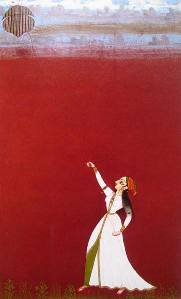
 |
|
Lady Flying a Kite, Bikaner or Jodhpur, 1730-1750. Photos Provided by Victoria and Albert Museum |
The third section, Beyond the Palace, focuses on Indian rulers' way of life outside the palace to show their ability to protect the people from external threats. The vision of a king riding a richly caparisoned elephant or horse was believed to be auspicious.
What is worth noting is that some patterns on the decor indicate cultural exchange between India and other countries. For instance, an exhibited pair of red embroidered panels from North India features flowers in two jars. And the jars' shape clearly suggests that they were imported from China.
The final section, The Influence of the West, examines the impact of Western culture in the Indian courts.
In the 18th and 19th centuries, Western goods and technologies were brought into India by European trading companies, most notably the English East India Company, which became a major military and political power during the latter part of the period. Rulers turned to European-inspired art and design to express their power and status.
This can be easily seen from the oil portrait of Muhammad Ali Khan, painted by the British artist Tilly Kettle, the first well-known British portrait painter to work in India. Western painting techniques such as perspective, chiaroscuro and sense of space were applied to the portrait.